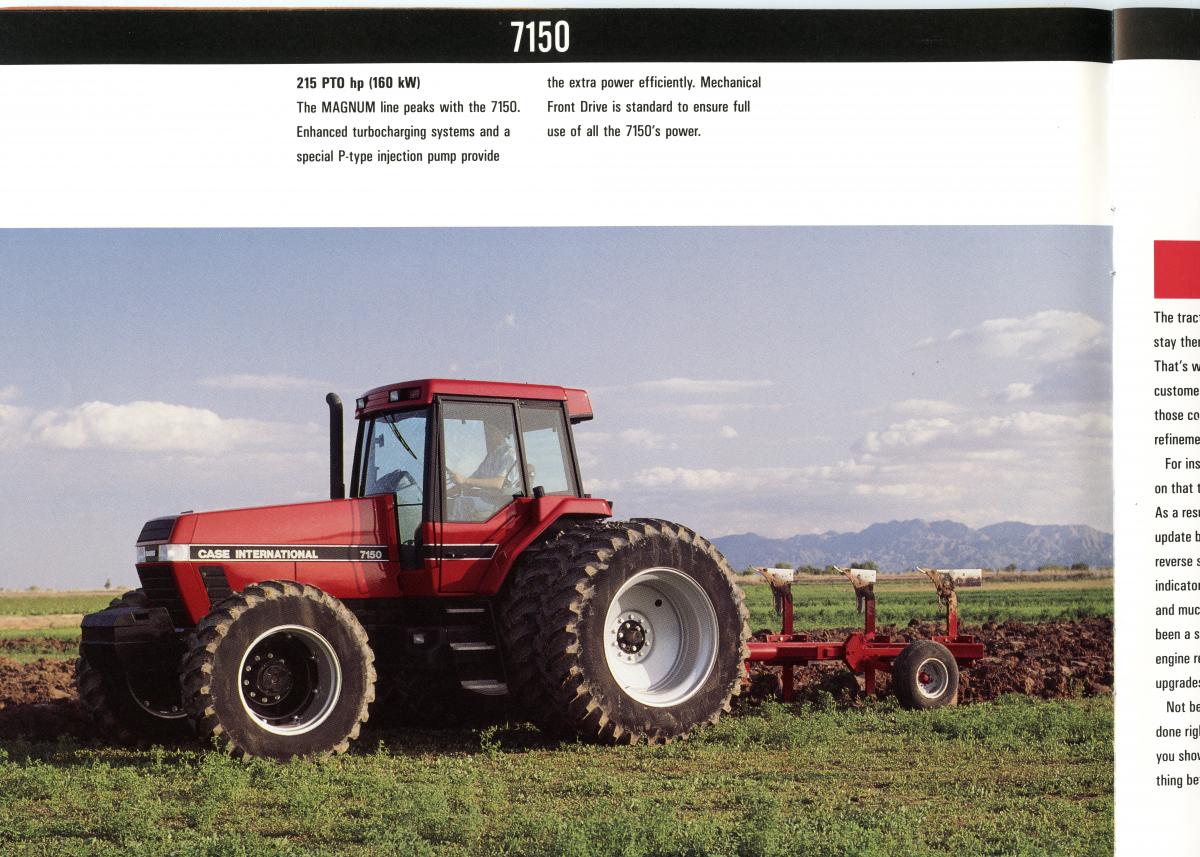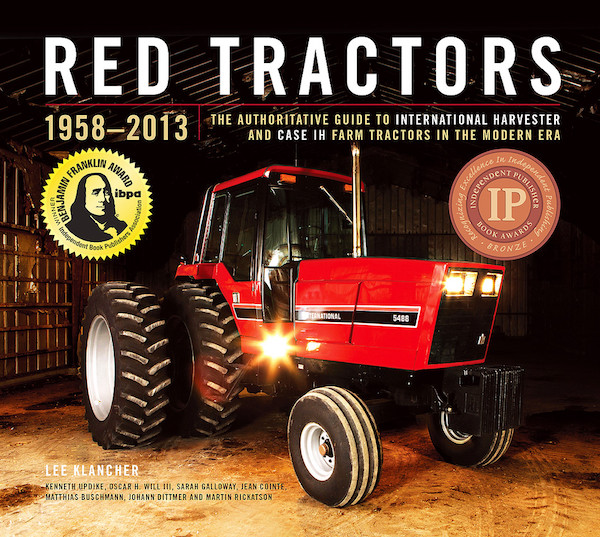Magnum 7150

The success of the 7100 series Magnum tractors in the Southwest United States brought a demand for a tractor with more engine horsepower and hydraulic lift capacity. Case IH developed the 7150 Magnum tractor to meet this need.
Starting in late 1990 and early 1991, a very limited number of these units were sold through the Memphis sales office to select dealers in southern states. These were to be kept in the area for close factory followup. After being cleared for production, the 7150 was released for sale to all Case IH dealers nationwide with the high-horsepower tractor contract starting in November 1991. Mass production and availability began in March 1992.
The Magnum 7150 was a boosted-horsepower model released in late 1990 and early 1991. The 215 horsepower from the 8.3-liter CDC engine made it the first Magnum with more than 200 horsepower—not to mention the most powerful mechanical front-drive tractor on the market. CNH Global
The 7150 was a more powerful tractor than the 7140, and was equipped with components beefy enough to deliver that power to the ground. The 215-horsepower output made the 7150 the highest horsepower mechanical-front-drive (MFD) tractor on the market when it was introduced. It met requests from large operators needing increased horsepower and greater three-point lifting capacity. It was the largest row-crop tractor available on the market.
The 7150’s CDC 505-cubic-inch (8.3-liter) diesel engine delivered excellent fuel efficiency. A new Holset-brand waste-gate turbocharger provided more consistent turbo boost pressure through the entire rpm range. At lower engine rpms the waste gate is closed, sending all exhaust flow to the turbocharger and thus improving horsepower and torque. When engine speed increases, the waste-gate valve moves to reduce exhaust flow to the turbo. Engine horsepower and torque curves are matched to the tractor.
A new turbo alone does not make horsepower. The 7150 used a Nippondenso P-type fuel-injection pump that operated at higher injection pressures than the Bosch pump on the 7140. Higher injection pressure allows fuel to atomize more efficiently for more complete fuel burn and better economy. The new pump had large-diameter plungers for optimum fuel efficiency. A pressure-damper valve reduced incoming fuel-pressure spikes, giving a smooth fuel flow resulting in consistent fuel metering. The system’s peak injection pressure is created at low engine speed, increasing low-speed torque for improved load starting. This was most evident in the low to midrange of engine rpms.
Since the injection pump runs at higher pressures, the rest of the injection pump drive system needs to be matched to it. This increases the torque on the camshaft and camshaft drive gear. A new forged steel camshaft and cam-drive gear were used on the 7150, along with a newly designed cylinder head with a low swirl. The head’s intake ports were tuned with a larger diameter to provide smooth air flow for improved engine efficiency and response. The low-swirl head design let the engine breathe easier, too.
More horsepower also creates an engine’s arch nemesis: heat. The 7150 was built with a larger capacity radiator that had seven rows of tubes and nine fins per inch for extra cooling surface. The engine side panels also had vented screens to increase the grille area by 40 percent. The side screens, which allowed the 7150 to cool better in trashy conditions, were offered only on the 7150. None of the other 7100 series Magnum tractors had them factory-installed.
Bolted right behind the engine was the familiar Magnum 18-speed full power-shift gearbox, the same transmission as that in the 7140. Today, it is not uncommon to find Magnum tractors with tens of thousands of hours on the meter and the transmission still untouched. In addition, an optional transmission creeper drive for the 7150 gave an additional six forward and two reverse speeds.
The 7150 cab was the same as that on other 7100 series Magnums, with more than 47 square feet of glass and the best visibility of any tractor on the market. The front window reached from floor to ceiling, and the large right-hand window had no mid-mounted cab post to block the view. In addition, a clear view of the hitch made implement hookup easy. The deluxe interior package came standard on the 7150.
The 7150 had 120-inch heavy-duty rear axles with a heavier axle housing casting that was 4 inches wider for increased strength. Heavier axle carrier bearings and axle seals that were both larger in diameter and heavier in design were standard.
Another feature of the 7150 requested by operators of larger farms was the additional hydraulics—specifically, more three-point hitch-lifting capacity. The 7150 used two 2.25-inch-diameter external lifting cylinders to deliver 14,950 pounds of hitch-lifting force. This extra lift power was needed by farmers with heavy minimum-till, ridge-till, and no-till mounted implements.
A new Fargo-style (a.k.a. Steiger) rear three-point quick hitch coupler was standard equipment on the 7150, making the mounting of heavy implements more convenient and safe. The Category III quick hitch also increased the ground clearance of mounted implements.
Three remote hydraulic valves were standard on the 7150, as was in-cab flow control. Competitive makers place flow control at the outlets, outside of the cab, which is very inconvenient.
To help keep the power on the ground, an 18-weight front bracket was standard on the 7150. For very heavy three-point hitch applications, a new 22-weight front bracket was developed that did not limit the narrow tread setting and front steering radius. If the tractor was used for narrow crop operations, the 18-weight bracket was installed.
All Magnum 7150s were covered by the 5-year/5,000-hour warranty. Every part on the tractor was covered except the tires, which came with their own manufacturer warranty.
To find out the rest of the incredible story of International Harvester, get your copy of Red Tractors 1958-2013 here!
Previous Excerpt - Next Excerpt

